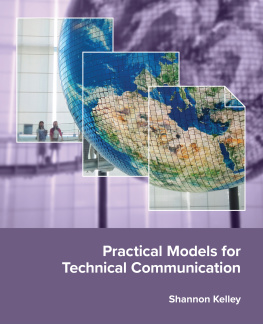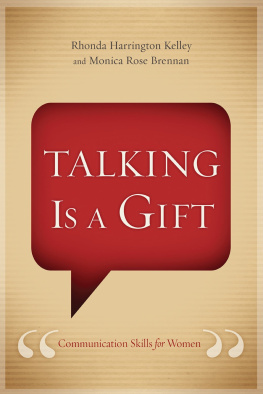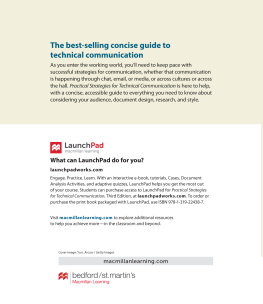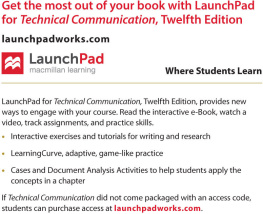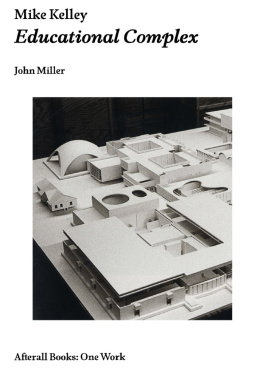Kelley Shannon - Practical Models for Technical Communication
Here you can read online Kelley Shannon - Practical Models for Technical Communication full text of the book (entire story) in english for free. Download pdf and epub, get meaning, cover and reviews about this ebook. year: 2021, publisher: Chemeketa Press, genre: Home and family. Description of the work, (preface) as well as reviews are available. Best literature library LitArk.com created for fans of good reading and offers a wide selection of genres:
Romance novel
Science fiction
Adventure
Detective
Science
History
Home and family
Prose
Art
Politics
Computer
Non-fiction
Religion
Business
Children
Humor
Choose a favorite category and find really read worthwhile books. Enjoy immersion in the world of imagination, feel the emotions of the characters or learn something new for yourself, make an fascinating discovery.
- Book:Practical Models for Technical Communication
- Author:
- Publisher:Chemeketa Press
- Genre:
- Year:2021
- Rating:5 / 5
- Favourites:Add to favourites
- Your mark:
- 100
- 1
- 2
- 3
- 4
- 5
Practical Models for Technical Communication: summary, description and annotation
We offer to read an annotation, description, summary or preface (depends on what the author of the book "Practical Models for Technical Communication" wrote himself). If you haven't found the necessary information about the book — write in the comments, we will try to find it.
Practical Models for Technical Communication — read online for free the complete book (whole text) full work
Below is the text of the book, divided by pages. System saving the place of the last page read, allows you to conveniently read the book "Practical Models for Technical Communication" online for free, without having to search again every time where you left off. Put a bookmark, and you can go to the page where you finished reading at any time.
Font size:
Interval:
Bookmark:

Edition 1.0
Shannon Kelley
Practical Models for Technical Communication
2018, 2019, 2021 Chemeketa Community College
ISBN-13: 978-1-943536-95-5
All rights reserved. Edition 0.8 2018. Edition 0.9 2019. Edition 0.95 2021. Edition 1.0 2021.
No part of this book may be reproduced or transmitted in any form or by any means, electronic or mechanical, including photocopying, recording, or by any information storage and retrieval system, without permission in writing from the publisher.
Chemeketa Press
Chemeketa Community College
4000 Lancaster Dr NE
Salem, Oregon 97301
chemeketapress.org
For desk copies or ordering inquiries, contact .
Cover design by Ronald Cox IV
Interior design by Ronald Cox IV, Cassandra Johns, Brice Spreadbury
and constitute an extension of the copyright page.
References to website URLs were accurate at the time of writing. Neither the author nor Chemeketa Press is responsible for URLs that have changed or expired since the manuscript was prepared.
This textbook is made possible, in part, by a grant from John and Bobby Clyde to support faculty involvement in textbook affordability efforts.
Printed in the United States of America.
Land Acknowledgment
Chemeketa Press is located on the land of the Kalapuya, who today are represented by the Confederated Tribes of the Grand Ronde and the Confederated Tribes of the Siletz Indians, whose relationship with this land continues to this day. We offer gratitude for the land itself, for those who have stewarded it for generations, and for the opportunity to study, learn, work, and be in community on this land. We acknowledge that our Colleges history, like many others, is fundamentally tied to the first colonial developments in the Willamette Valley in Oregon. Finally, we respectfully acknowledge and honor past, present, and future Indigenous students of Chemeketa Community College.
Welcome to the future of technical communication. This book began with feedback from students in technical communication courses. They wanted a book with better visuals, organization, and models. They wanted a book that was easy to navigate and streamlined for their needs. They wanted a useful and practical book with a price tag that didnt make them break out in a cold sweat. At every step of the way, the instructors who contributed to this book had you in mind.
We invite you to approach this textbook as a term-length usability study. In usability testing, the developers of a product evaluate its performance by observing how the target audience use the product. This textbook is designed to provide you with solid tools, useful models, interesting scenarios, and a vocabulary of technical terms that will allow you to communicate effectively as part of a fast-paced, global workforce.
To get the most out of this book, you must first read the pages assigned by your instructor. After youve done that, take a step back and consider how the book, chapter, or section you just read works as an example of technical communication. Like any text, you should approach this book with a curious and critical mind. If one of the books models or templates helps you understand a concept, let your instructor know. If we fail to follow our own rules, let your instructor know. You are part of our development team now.
Abstracts: The abstracts at the beginning of each chapter demonstrate concise, specific writing that sums up the chapter. This pedagogical element reinforces an essential technical skill.
Annotated models: Marginal notes accompany every model to identify places where the document is working or needs work. The notes encourage you to interact critically with the documents and understand specific examples of the chapters concepts.
Bold terms and glossary: Each chapter begins with a list of key terms that will be introduced. When important terms are first mentioned, they are always in bold and accompanied by a sentence definition. This book has an entire chapter on technical descriptions and definitions, but each bold term can be treated as a mini-lesson in writing effective definitions. The glossary at the end collects all the definitions for easy reference.
Case studies: At the end of each chapter, case studies invite you to think about ways to apply the concepts youre learning. These compact scenarios show how individuals interact with technical communication principles in the workplace and beyond.
Checklists: The checklists at the end of each chapter break down complex tasks into smaller steps. They are designed to be used, so check off each box to track your progress.
Extended technical scenarios: In each chapter, you will follow a character who must create a technical document. As with any good story, each character encounters challenges, and their drafts serve as a starting place to begin seeing yourself as a technical communicator.
Figures, tables, and charts: Whenever possible, this book aims to translate concepts into visuals to support the text.
Instructional captions: The captions are designed to reinforce the visual information provided by the figures. Rather than restating the books content, the captions provide bite-sized supplemental information about the concept to enhance understanding.
Looking Ahead sections: Every chapter opens with a table of contents in miniature. This section offers a quick overview of the chapter to assist in your preparation for class.
Marginal notes: The notes in the margins reveal the connections within the text by pointing to other chapters where a concept is discussed in greater depth.
Problem-Solution Framework: This framework provides a conceptual model to illustrate the goals of technical communication. This model embraces the importance of purpose, audience, and message and adds to it by emphasizing how technical communicators are hired to solve problems.
Traffic signals: Models of technical documents are accompanied by traffic signals that indicate how finished the document is. A red light indicates a document that is at the beginning stages or insufficient. The hope is that youll stop at these models to examine why they arent working. Models with a yellow light show a work in progress. Models with a green light are final versions that are ready to go out into the world.
Chemeketa Press would like to build resources that align with this textbook. If you have a classroom activity, student model, assignment, or syllabus that works with this text, please share it with us. We hope to use these resources (with your permission) to create a toolbox for future instructors who use this textbook. Please feel free to contact us at .

Abstract: Welcome to technical communication. Each chapter begins with an abstract that models concise writing and prepares you for the content to come. As youll learn in this book, technical communication is a journey from problem to solution. The technical communicator must use and arrange clear, concise, precise, and accurate information to create successful, user-friendly documents. Different media, such as images or videos, often help make this information understandable. The key is to know the materials purpose and its audience, called the user in this book, and choose the best form for the message. If users can solve their problems or accomplish their goals using content you create, they win, you win, and your employer wins. This chapter also introduces you to the Problem-Solution Framework that will guide your choices as you become a more proficient technical communicator.
Font size:
Interval:
Bookmark:
Similar books «Practical Models for Technical Communication»
Look at similar books to Practical Models for Technical Communication. We have selected literature similar in name and meaning in the hope of providing readers with more options to find new, interesting, not yet read works.
Discussion, reviews of the book Practical Models for Technical Communication and just readers' own opinions. Leave your comments, write what you think about the work, its meaning or the main characters. Specify what exactly you liked and what you didn't like, and why you think so.

